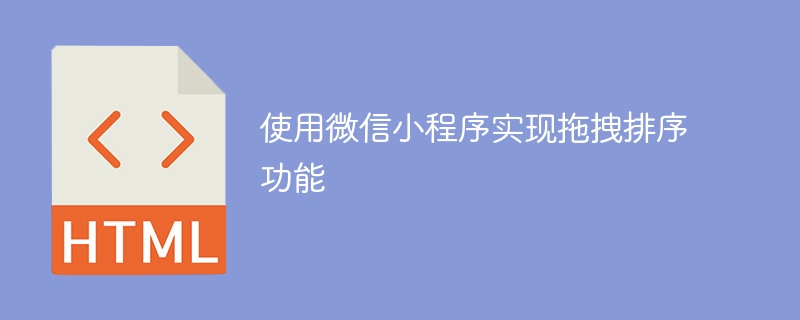使用微信小程序实现拖拽排序功能

使用微信小程序实现拖拽排序功能 示例代码
刚开始学习微信小程序时,我一直以为实现拖拽排序功能是很困难的事情。然而,通过深入研究官方文档和尝试不同的方法,我终于成功地实现了这一功能。在本篇文章中,我将分享实现拖拽排序功能的具体代码示例。
首先,在 wxml 文件中创建一个包含所有可排序项的列表。例如:
<view class="sortable-list">
<view wx:for="{{items}}" wx:key="unique-key" wx:for-item="item" wx:for-index="index" class="sortable-item"
data-index="{{index}}" bindtouchstart="onDragStart" bindtouchmove="onDragging" bindtouchend="onDragEnd"
bindtouchcancel="onDragEnd">
{{item}}
</view>
</view>在样式文件 wxss 中,我们需要给可排序项添加一些样式,使其可以拖拽。例如:
.sortable-item {
padding: 10rpx;
background-color: #F7F7F7;
margin-bottom: 10rpx;
border: 1rpx solid #CCCCCC;
-webkit-transition: all 0.3s;
transition: all 0.3s;
}
.sortable-item.dragging {
opacity: 0.6;
-webkit-transform: scale(0.95);
transform: scale(0.95);
z-index: 999;
border-color: #33CCFF;
}在对应的 js 文件中,我们需要定义一些事件处理函数来实现拖拽排序。首先,我们需要在页面的 data 字段中定义一个排序列表 items 和一个正在拖拽中的索引值 draggingIndex:
Page({
data: {
items: ['Item 1', 'Item 2', 'Item 3', 'Item 4', 'Item 5'],
draggingIndex: -1
},
// ...
});接下来,我们需要实现拖拽开始、拖拽过程和拖拽结束的事件处理函数:
Page({
data: {
// ...
},
onDragStart(e) {
this.setData({
draggingIndex: e.currentTarget.dataset.index
});
},
onDragging(e) {
const index = e.currentTarget.dataset.index;
const draggingIndex = this.data.draggingIndex;
if (draggingIndex !== -1) {
const items = this.data.items;
const [item] = items.splice(draggingIndex, 1);
items.splice(index, 0, item);
this.setData({
items
});
this.setData({
draggingIndex: index
});
}
},
onDragEnd(e) {
this.setData({
draggingIndex: -1
});
}
});在拖拽开始事件处理函数 onDragStart 中,我们获取当前拖拽项的索引值,并将其保存到数据中的 draggingIndex 字段。
在拖拽过程事件处理函数 onDragging 中,我们将拖拽项从原位置移除,并插入到当前拖拽位置。最后,我们将修改后的列表保存到数据中,同时更新当前拖拽项的索引值。
在拖拽结束事件处理函数 onDragEnd 中,我们将数据中的 draggingIndex 字段重置为 -1,表示拖拽过程结束。
以上就是实现微信小程序拖拽排序功能的完整代码示例。通过运行这段代码,我们就可以在小程序中实现拖拽排序功能了。希望这个代码示例对大家有所帮助!如果有任何问题,欢迎随时提问!
以上是使用微信小程序实现拖拽排序功能的详细内容。更多信息请关注PHP中文网其他相关文章!

热AI工具

Undresser.AI Undress
人工智能驱动的应用程序,用于创建逼真的裸体照片

AI Clothes Remover
用于从照片中去除衣服的在线人工智能工具。

Undress AI Tool
免费脱衣服图片

Clothoff.io
AI脱衣机

AI Hentai Generator
免费生成ai无尽的。

热门文章

热工具

记事本++7.3.1
好用且免费的代码编辑器

SublimeText3汉化版
中文版,非常好用

禅工作室 13.0.1
功能强大的PHP集成开发环境

Dreamweaver CS6
视觉化网页开发工具

SublimeText3 Mac版
神级代码编辑软件(SublimeText3)

热门话题
 闲鱼微信小程序正式上线
Feb 10, 2024 pm 10:39 PM
闲鱼微信小程序正式上线
Feb 10, 2024 pm 10:39 PM
闲鱼官方微信小程序悄然上线,在小程序中可以发布闲置与买家/卖家私信交流、查看个人资料及订单、搜索物品等,有用好奇闲鱼微信小程序叫什么,现在快来看一下。闲鱼微信小程序叫什么答案:闲鱼,闲置交易二手买卖估价回收。1、在小程序中可以发布闲置、与买家/卖家私信交流、查看个人资料及订单、搜索指定物品等功能;2、在小程序的页面中有首页、附近、发闲置、消息、我的5项功能;3、想要使用的话必要要开通微信支付才可以购买;
 微信小程序实现图片上传功能
Nov 21, 2023 am 09:08 AM
微信小程序实现图片上传功能
Nov 21, 2023 am 09:08 AM
微信小程序实现图片上传功能随着移动互联网的发展,微信小程序已经成为了人们生活中不可或缺的一部分。微信小程序不仅提供了丰富的应用场景,还支持开发者自定义功能,其中包括图片上传功能。本文将介绍如何在微信小程序中实现图片上传功能,并提供具体的代码示例。一、前期准备工作在开始编写代码之前,我们需要先下载并安装微信开发者工具,并注册成为微信开发者。同时,还需要了解微信
 如何利用Laravel实现用户权限管理功能
Nov 02, 2023 pm 02:09 PM
如何利用Laravel实现用户权限管理功能
Nov 02, 2023 pm 02:09 PM
如何利用Laravel实现用户权限管理功能随着Web应用程序的发展,用户权限管理在许多项目中变得越来越重要。Laravel作为流行的PHP框架,为处理用户权限管理提供了许多强大的工具和功能。本文将介绍如何使用Laravel实现用户权限管理功能,并提供具体的代码示例。数据库设计首先,我们需要设计一个数据库模型来存储用户、角色和权限的关系。为了简化操作,我们将使
 实现微信小程序中的下拉菜单效果
Nov 21, 2023 pm 03:03 PM
实现微信小程序中的下拉菜单效果
Nov 21, 2023 pm 03:03 PM
实现微信小程序中的下拉菜单效果,需要具体代码示例随着移动互联网的普及,微信小程序成为了互联网开发的重要一环,越来越多的人开始关注和使用微信小程序。微信小程序的开发相比传统的APP开发更加简便快捷,但也需要掌握一定的开发技巧。在微信小程序的开发中,下拉菜单是一个常见的UI组件,实现了更好的用户操作体验。本文将详细介绍如何在微信小程序中实现下拉菜单效果,并提供具
 实现微信小程序中的图片滤镜效果
Nov 21, 2023 pm 06:22 PM
实现微信小程序中的图片滤镜效果
Nov 21, 2023 pm 06:22 PM
实现微信小程序中的图片滤镜效果随着社交媒体应用的流行,人们越来越喜欢在照片中应用滤镜效果,以增强照片的艺术效果和吸引力。在微信小程序中也可以实现图片滤镜效果,为用户提供更多有趣和创造性的照片编辑功能。本文将介绍如何在微信小程序中实现图片滤镜效果,并提供具体的代码示例。首先,我们需要在微信小程序中使用canvas组件来加载和编辑图片。canvas组件可以在页面
 使用微信小程序实现轮播图切换效果
Nov 21, 2023 pm 05:59 PM
使用微信小程序实现轮播图切换效果
Nov 21, 2023 pm 05:59 PM
使用微信小程序实现轮播图切换效果微信小程序是一种轻量级的应用程序,具有简单、高效的开发和使用特点。在微信小程序中,实现轮播图切换效果是常见的需求。本文将介绍如何使用微信小程序实现轮播图切换效果,并给出具体的代码示例。首先,在微信小程序的页面文件中,添加一个轮播图组件。例如,可以使用<swiper>标签来实现轮播图的切换效果。在该组件中,可以通过b
 闲鱼微信小程序叫什么
Feb 27, 2024 pm 01:11 PM
闲鱼微信小程序叫什么
Feb 27, 2024 pm 01:11 PM
闲鱼官方微信小程序已经悄然上线,它为用户提供了一个便捷的平台,让你可以轻松地发布和交易闲置物品。在小程序中,你可以与买家或卖家进行私信交流,查看个人资料和订单,以及搜索你想要的物品。那么闲鱼在微信小程序中究竟叫什么呢,这篇教程攻略将为您详细介绍,想要了解的用户们快来跟着本文继续阅读吧!闲鱼微信小程序叫什么答案:闲鱼,闲置交易二手买卖估价回收。1、在小程序中可以发布闲置、与买家/卖家私信交流、查看个人资料及订单、搜索指定物品等功能;2、在小程序的页面中有首页、附近、发闲置、消息、我的5项功能;3、
 如何使用PHP开发微信小程序的二手交易功能?
Oct 27, 2023 pm 05:15 PM
如何使用PHP开发微信小程序的二手交易功能?
Oct 27, 2023 pm 05:15 PM
如何使用PHP开发微信小程序的二手交易功能?微信小程序作为一种热门的移动应用开发平台,被越来越多的开发者所使用。在微信小程序中,二手交易是一种常见的功能需求。本文将介绍如何使用PHP开发微信小程序的二手交易功能,并提供具体的代码示例。一、准备工作在开始开发前,需要先确保已具备以下条件:微信小程序的开发环境已搭建完成,包括注册小程序的AppID,并在小程序后台






